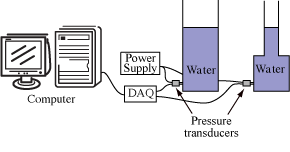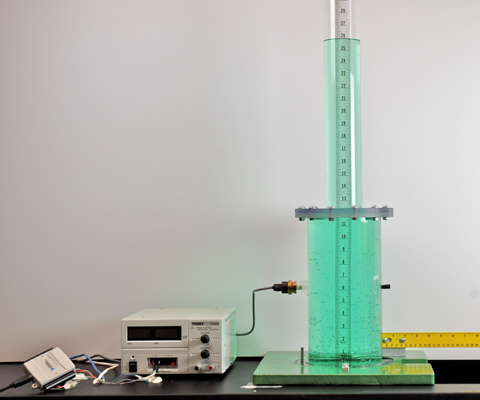The Tank Filling Experiment
Overview
Apparatus
The apparatus consists of a straight (constant diameter) tank, one stepped (variable diameter) tank, a pressure transducer mounted near the bottom of each tank, a power supply for the transducers, a data acquisition system, and a computer to record the data captured by the data acquisition system.

Figure 1: Schematic of the apparatus for the tank filling experiment.
The tanks are constructed from acrylic. Each tank has a pressure transducer located appoximately cm up from the bottom. Scales are mounted on the sides of the tanks to indicate the depth of the water. The bottom of the scales is located at the centerline of the pressure transducer.

Figure 2: Step-walled tank, pressure transducer, power supply and data acquisition system.
The data acquisition system is a NI USB-6008 device from National Instruments. The device has 8 analog inputs, 2 analog outputs, 12 digital I/O, and a 32 bit counter. For this exercise only 1 analog input is needed. The DAQ device is controlled by a LabVIEW program running on the computer. The program collects the pressure information, plots the pressure values in a strip chart, and indicates the instantaneous values of the pressure on an indicator.
In-class Demonstration
The tank-filling exercise can be used as a 15 minute in-class demonstration, or as a one-and-a-half hour lab exercise. The in-class demonstration can be used to motivate a derivation of the hydrostatic equation, and to address misconceptions about the variables affecting pressure in a stationary fluid.
Lab Exercise
The guided-inquiry laboratory exercise takes about one and a half hours. The laboratory worksheet contains instructions for completing steps of the experiment. It also contains questions that require experimental investigation to answer.
Learning Objectives
As a result of completing this exercise, students will be able to...
- Identify a pressure transducer an explain its role in measuring/transmitting pressure values to a data collection system.
- Identify the fluid properties and other physical variables that determine the pressure at some depth in a tank partially filled with water and open to air.
- Predict the trend in pressure with tank depth.
- Compute the pressure at any depth below the free surface of a tank partially filled with liquid.
- Predict how the relationship between pressure and depth changes with the shape of the tank.

|
Funded by NSF DUE #0633754. Any opinions, findings, and conclusions or recommendations expressed in this material are those of the author(s) and do not necessarily reflect the views of the National Science Foundation |